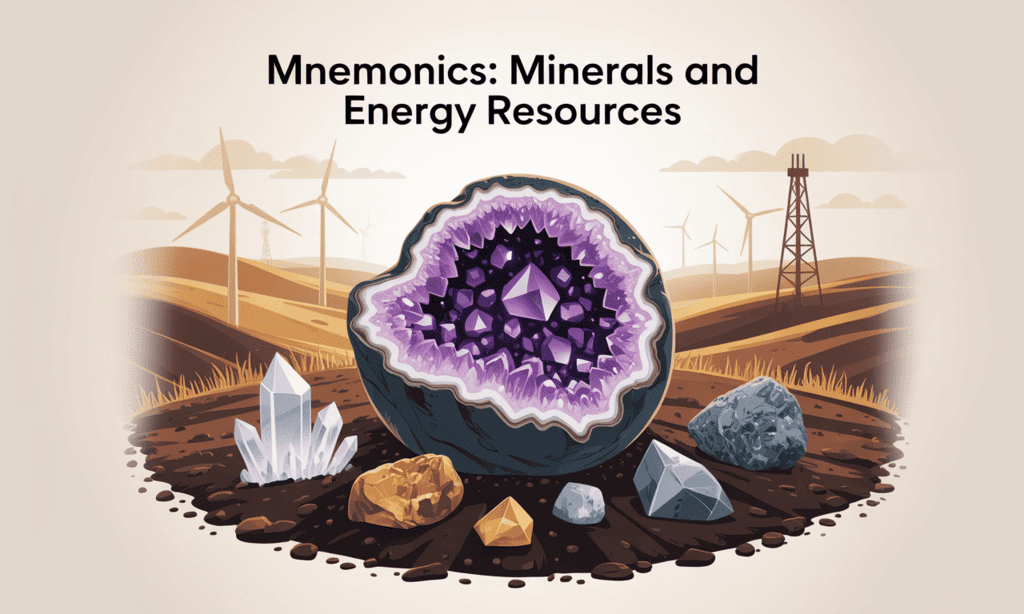Class 10 Exam > Class 10 Notes > Social Studies (SST) Class 10 > Mnemonics: Minerals and Energy Resources
Mnemonics: Minerals and Energy Resources | Social Studies (SST) Class 10 PDF Download

1. Definition & Types of Mineral Occurrence (ISDAO)
Mnemonic: "I Saw Dangerous Alligators Outside"
- I – Igneous and Metamorphic rocks
- S – Sedimentary rocks
- D – Decomposition of surface rocks
- A – Alluvial (Placer) deposits
- O – Ocean water and beds
2. Types of Iron Ore Belts in India (ODBM)
Mnemonic: "Old Dogs Bark Madly"
- O – Odisha-Jharkhand Belt
- D – Durg-Bastar-Chandrapur Belt
- B – Ballari-Chitradurga-Tumakuru Belt
- M – Maharashtra-Goa Belt
3. Ferrous vs Non-Ferrous Minerals (FICCBM)
Mnemonic: "Ferrous Includes Cool Copper, Bauxite, and More"
Ferrous:
- I – Iron
- M – Manganese
Non-Ferrous:
- C – Copper
- B – Bauxite
4. Conventional Energy Sources (CPNGEC)
Mnemonic: "Can People Not Get Easy Coal?"
- C – Coal
- P – Petroleum
- N – Natural Gas
- G – (Grid) Electricity
- E – Electricity
- C – Cow dung / Firewood
5. Non-Conventional Energy Sources (SNWBGT)
Mnemonic: "Some New Ways Bring Great Transformation"
- S – Solar Energy
- N – Nuclear/Atomic Energy
- W – Wind Energy
- B – Biogas
- G – Geothermal Energy
- T – Tidal Energy
6. Hazards of Mining (DPIFW)
Mnemonic: "Dusty People Inhaled Fumes & Wept"
- D – Dust causes lung diseases
- P – Possibility of collapse/inundation/fire
- I – Inhalation of fumes
- F – Fires in coal mines
- W – Water contamination
7. Conservation of Minerals (RIRI)
Mnemonic: "Recycle It, Reuse It"
- R – Reduce wasteful extraction
- I – Improve technology to use low-grade ores
- R – Recycle metals
- I – Increase awareness
8. Conservation of Energy Resources (PSPU)
Mnemonic: "Please Save Precious Units"
- P – Public transport over private vehicles
- S – Switch off electricity when not in use
- P – Power-saving devices
- U – Use renewable sources
The document Mnemonics: Minerals and Energy Resources | Social Studies (SST) Class 10 is a part of the Class 10 Course Social Studies (SST) Class 10.
All you need of Class 10 at this link: Class 10
|
66 videos|614 docs|79 tests
|
FAQs on Mnemonics: Minerals and Energy Resources - Social Studies (SST) Class 10
| 1. What are the major types of minerals, and how are they classified? |  |
Ans. Minerals are generally classified into two major categories: metallic minerals and non-metallic minerals. Metallic minerals include valuable metals such as iron, copper, and aluminum, which are extracted for industrial use. Non-metallic minerals consist of materials like coal, limestone, and clay, which are used in various construction and manufacturing processes. Additionally, minerals can be categorized based on their origin, such as igneous, sedimentary, and metamorphic minerals.
| 2. How do renewable energy resources differ from non-renewable energy resources? |  |
Ans. Renewable energy resources, such as solar, wind, hydro, and biomass, are derived from natural processes that replenish themselves over time. These resources are considered sustainable and have a minimal environmental impact. In contrast, non-renewable energy resources, like coal, oil, and natural gas, are finite and will deplete over time as they are consumed. The extraction and use of non-renewable resources often lead to environmental degradation and pollution.
| 3. What is the significance of conserving mineral resources? |  |
Ans. Conserving mineral resources is crucial for sustainable development and environmental protection. As mineral resources are finite, their over-exploitation can lead to depletion, increased costs, and ecological imbalance. Conservation practices, such as recycling and efficient usage, help extend the life of these resources, reduce waste, and minimize the environmental impact of mining activities. This is essential for future generations and maintaining biodiversity.
| 4. What are some common methods of extracting minerals? |  |
Ans. Common methods of mineral extraction include surface mining, underground mining, and placer mining. Surface mining involves removing the overburden to access minerals near the Earth's surface, while underground mining is used for deep deposits where minerals are extracted from tunnels. Placer mining involves extracting minerals from riverbeds and beaches, often used for precious metals like gold. Each method has its own environmental impacts and costs associated with it.
| 5. How does the use of minerals and energy resources impact the economy? |  |
Ans. The extraction and utilization of minerals and energy resources play a vital role in economic development. They provide essential raw materials for various industries, create jobs, and contribute to national income through exports. However, reliance on these resources can also lead to economic vulnerabilities, especially in regions that depend heavily on a single resource. Therefore, diversification and sustainable practices are important for long-term economic stability.
Related Searches
















